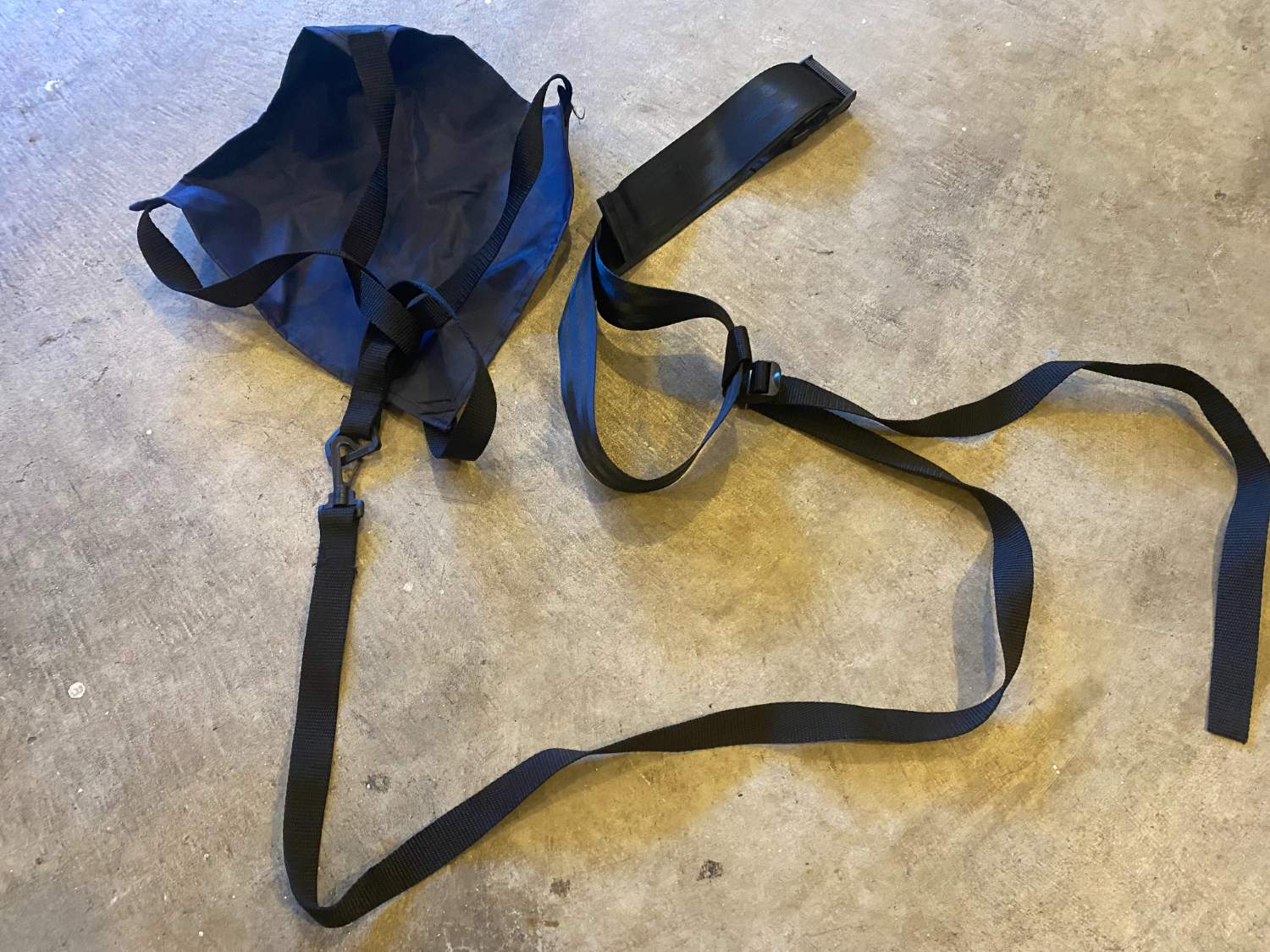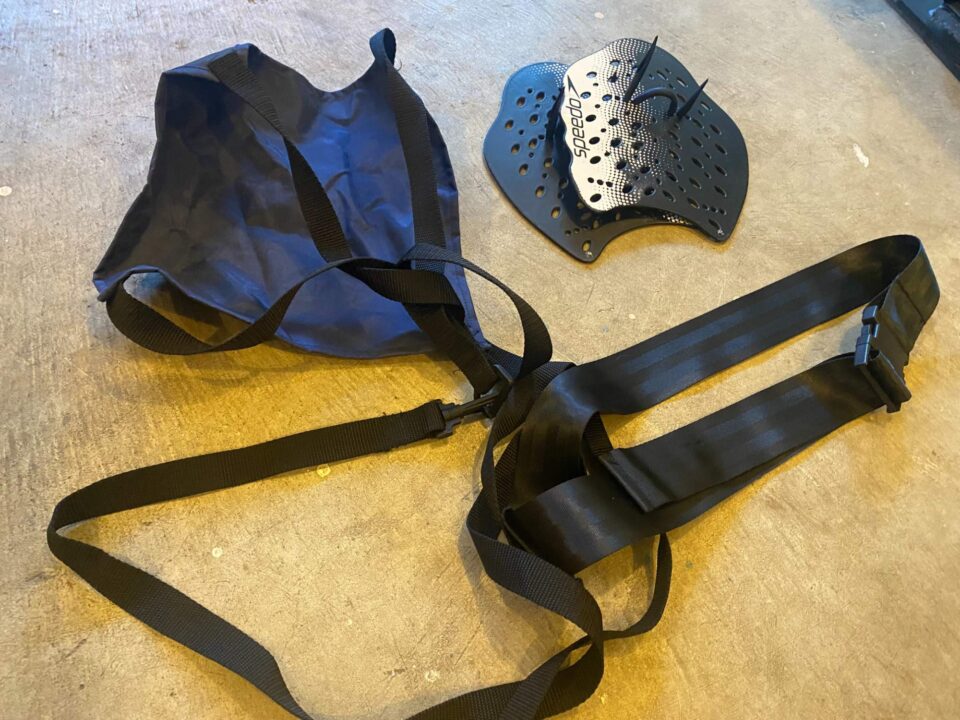Swim parachutes, also known as drag chutes, are a tool for resisted swim training. Here’s a look at how a chute can help improve your swim performance.
Swim gear has exploded in recent years, with a wide variety of aids, tech, and equipment designed to help swim performance.
One of my favorites is on the low-tech side of things, the swim parachute.
Highly portable and ideal for swimmers who train on their own, swim parachutes, also known as drag chutes, are a simple belt, nylon strap, and a variable-sized chute that increases resistance when swimming.
Kind of like swimming with a water-logged wool sweater dangling behind you.
Like other types of swimming resistance tools, such as DragSox, power towers, weight belts, or swim tethers, swim parachutes can help increase swim velocity, improve body position, and even help address strokes that lag too much between propulsive phases (i.e. excessive catch-up).
In this little ditty, we are going to look at the three benefits of using a swim parachute. The reference is a study published in the Journal of Sports Biomechanics that evaluated the effectiveness of training with a swim parachute with competitive swimmers.
We’ll look at the results of the study, key takeaways, and some practical applications for swimmers.
Let’s dive in and get our chute on.
The Effects of Swim Parachute Training for Faster Swimming
Alrighty, let’s take a look at the study.
Titled “The influence of an 11-week resisted swim training program on the inter-arm coordination in front crawl swimmers,” the 11-week intervention measured the performance of 14 experienced competitive swimmers.
The competitive swimmers were all female, average age of 13 years, and split into two groups (7 for the control, 7 for the intervention).
To test for potential improvements, all the swimmers performed 2x50m freestyle time trials before and after the testing period.

For the intervention, the chute group performed a set of sprints with a parachute four times per week in addition to their regular swim training. The control group did the same sets, but without the chute.
The parachute group alternated between the two sets, doing both twice per week:
- 3x [6x15m freestyle all out with chute @ 60 seconds]
- 2x [4x25m freestyle all out with chute @ 90 seconds]
The parachute swimmers used a pull buoy to isolate the arm movement of the stroke and took five minutes rest between rounds to keep things consistent.
The results after 11 weeks, when all the swimmers retested the 2x50m freestyle all out?
1. Improved swim velocity
Following the training intervention, the chute group experienced a significant increase in swimming velocity while the speed for the control group was essentially unchanged.
Mean swimming velocity increased for the intervention group (1.27m/s -> 1.32m/s) versus the control group (1.29m/s -> 1.28m/s).
| PRE | POST | |
| Intervention | 1.27m/s | 1.32m/s |
| Control | 1.29m/s | 1.28m/s |
That type of improvement is obviously eye-popping (and certainly also likely due to the swimmers’ age and relative inexperience with resisted swim training).
Nonetheless, speed is speed!
2. Increased stroke rate
Researchers credited an increased stroke rate for the faster swimming velocity.
The chute group, after the training period, increased their stroke rate while retaining stroke length.
Here is a look at the before and after stroke rates for both groups, measured in cycles/second:
| PRE | POST | |
| Intervention | 0.97 | 1.00 |
| Control | 0.94 | 0.93 |
While the increase was non-significant, “according to the marginal gains concept… small changes in these parameters may cause significant improvements in swimming velocity.”
3. Increased propulsive continuity
Another interesting benefit of training with a chute is that absolute and relative duration of the propulsive phases of the stroke increased while non-propulsive phases decreased.
More simply, swimmers spent more time in the propulsive phases of the stroke and less time in the phases of the stroke that did not generate propulsion.
The researchers measured propulsive continuity using a metric called “index of coordination,” which refers to the lag time between the propulsive and non-propulsive phases of the stroke.
Here is how the index of coordination (IDC) score works:
- A score below zero corresponds to what swimmers and coaches would term a catch-up stroke where there is a lot of lag between phases. The further south the score, the longer the gaps in propulsion.
- A score of exactly zero means that the inter-arm coordination results in propulsive phases that link equally.
- Greater than zero means propulsive phases overlap.
Here is how the swimmers performed when measured before and after the 11-weeks:
| PRE | POST | |
| Intervention | -14.69 | -8.60 |
| Control | -7.13 | -7.54 |
The intervention group started with a much worse IDC score but significantly increased the symmetry and continuity of the stroke following the intervention. The control group, as you can see above, got slightly worse.
The “propulsive continuity” findings in this study matches the finding of other research with paddles and swim parachutes that improved IDC scores among backstrokers (Telles et al., 2017) and butterflyers (Telles et al., 2015).
Key Takeaways
Alrighty, so what does this mean for you, the enterprising swimmer looking to get better and faster in the water?
(And yes, I know, the study has a small sample size, all the same biological sex, age groupers, limited exposure to resisted training, and all the rest. Standard limitations should be self-evident.)
Here are my key takeaways:
Swim chutes are a great way to increase overall swimming velocity.
Faster swimming—no complaints here!
Using a chute in the water, particularly for shorter durations with plenty of rest at maximum intensity, is the most specific type of in-water resistance training swimmers can do to develop strength.
Stronger swimming = faster swimming.
Power up your stroke rate.
Training with a chute increased stroke rate, making it an essential tool for swimmers looking to generate a faster, stronger stroke (i.e. sprinters).
Periodic training with a chute is an excellent way to train a higher stroke rate and build the strength endurance to maintain it.
Chutes are great for balancing out your stroke.
Swimmers struggling with excessive catch-up in their stroke can train with a chute to increase time in the propulsive phase and reduce lags and dead spots.
I’ve always enjoyed the benefits of training with a swim chute. It makes my stroke feel more balanced, positions my hips higher, and is excellent for post-activation potentiation sets. This study reinforces the advantages of incorporating a chute into training.
And the best part?
Doesn’t require a ton of time to do the sets as performed above and parachutes are portable and easy to use, even in busier lap pools.
Get your chute on, get your speed on, and happy swimming!
ABOUT OLIVIER POIRIER-LEROY
Olivier Poirier-Leroy is a former national-level swimmer, author, swim coach, and certified personal trainer. He’s the author of YourSwimBook, a ten-month logbook for competitive swimmers.
 He’s also the author of the best-selling mental training workbook for competitive swimmers, Conquer the Pool: The Swimmer’s Ultimate Guide to a High-Performance Mindset.
He’s also the author of the best-selling mental training workbook for competitive swimmers, Conquer the Pool: The Swimmer’s Ultimate Guide to a High-Performance Mindset.
It combines sport psychology research, worksheets, anecdotes, and examples of Olympians past and present to give swimmers everything they need to conquer the mental side of the sport.
Ready to take your mindset to the next level in the pool?
Click here to learn more about Conquer the Pool.

I’ve tried parachutes but disliked how my feet rubbed and scrapped against the cord repeatedly, even when I didn’t kick. I’ll have to try it with a swim buoy next time.
For sure. DragSox are also a good alternative. I prefer using chutes with fins as my toes don’t tangle in the strap when I inevitably kick it.
I remember a masters session about 8 years ago where we were all using parachutes. Despite usually being the fastest swimmer, I was mediocre at best with a parachute which definitely highlighted a huge dead spot in my stroke!! Maybe I need to go and buy one and do something about the problem!